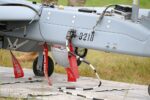In a significant demonstration of NATO’s evolving air power doctrine, Royal Canadian Air Force (RCAF) CF-188 Hornet fighter jets executed their first-ever highway landing in Estonia. The operation was part of Exercise “Agile Panther,” a component of the broader NATO Agile Combat Employment (ACE) concept aimed at enhancing force survivability and operational flexibility in contested environments.
Highway Landing Marks Operational First for Canada
On October 3, 2025, two RCAF CF-188 Hornets (the Canadian designation for the McDonnell Douglas F/A-18A/B legacy fighters) successfully landed and took off from a specially prepared section of the Jägala-Käravete highway in northern Estonia. This marked the first time Canadian fighter aircraft have conducted such a maneuver—a capability long practiced by Nordic air forces but new to North America-based squadrons.
The operation was executed by personnel from 433 Tactical Fighter Squadron (“Porcupine Squadron”) based at CFB Bagotville, Quebec. The squadron is currently deployed to Ämari Air Base as part of Canada’s contribution to NATO’s enhanced Air Policing mission in the Baltics. The event was coordinated with the Estonian Defence Forces and supported by NATO’s Allied Air Command.
Agile Combat Employment: Dispersal as Deterrence
The highway landing was not merely a stunt but a practical application of ACE—a U.S.-led concept now adopted across NATO that emphasizes dispersed basing, rapid mobility, and flexible force posture to counter anti-access/area denial (A2/AD) threats. By demonstrating that fighter aircraft can operate from non-traditional locations like highways or austere airstrips, ACE enhances survivability against precision missile strikes targeting fixed airbases.
“This capability sends a message,” said Brigadier-General Mark Goulden, Commander of 1 Canadian Air Division. “We are not tied to one base or runway. We can operate where needed—when needed.”
Estonia and other Baltic states are particularly invested in ACE due to their proximity to Russia’s Western Military District and Kaliningrad exclave—both heavily militarized zones with advanced long-range strike assets. Dispersed operations complicate adversary targeting cycles and enhance resilience during high-tempo conflict scenarios.
Baltic Allies Lead the Way in Road Runway Integration
Finland and Sweden—now both formal NATO members—have decades of experience operating fast jets from road bases as part of their Cold War-era Total Defence models. Finland’s F/A-18C/Ds routinely train on converted highways with minimal ground support infrastructure. Similarly, Swedish Gripens are designed with short takeoff/landing (STOL) performance optimized for road base use.
Estonia has been investing in dual-use infrastructure capable of supporting such operations since at least 2016. The Jägala-Käravete section used by the Canadians had previously hosted Finnish F/A-18s during joint exercises but had never seen Canadian aircraft until now.
This interoperability milestone underscores how smaller frontline nations are shaping NATO doctrine through practical innovation—and how larger allies like Canada are adapting accordingly.
CF-188 Legacy Fighters Still Deliver Strategic Value
The CF-188 fleet—based on the early F/A-18A/B variants—is scheduled for replacement by F-35A Lightning II aircraft beginning in 2026 under Canada’s Future Fighter Capability Project (FFCP). However, this highway landing proves that even aging platforms retain strategic utility when paired with forward-thinking concepts like ACE.
- Aircraft: McDonnell Douglas CF-188A/B (F/A-18A/B)
- Squadron: 433 Tactical Fighter Squadron
- Base: CFB Bagotville; deployed to Ämari AB
- Maneuver: Highway landing/takeoff on Jägala-Käravete road section
- Date: October 3, 2025
The mission required coordination between RCAF pilots and Estonian ground crews who secured the roadway segment—removing light poles and setting up arresting gear where necessary. Mobile fuel trucks and maintenance teams were positioned nearby to simulate combat turnarounds under expeditionary conditions.
NATO Integration Deepens Through Realistic Training
This event is part of Exercise Agile Panther—a bilateral training effort between Canada and Estonia nested within broader NATO deterrence activities such as Operation Reassurance and Baltic Air Policing. It also aligns with recent U.S. efforts under Dynamic Forward Posture initiatives that emphasize prepositioned logistics nodes and distributed command-and-control networks across Eastern Europe.
NATO spokesperson Colonel Arne Collatz noted that “such exercises demonstrate Alliance cohesion and adaptability.” He added that “the ability to project combat power from unexpected locations is essential given current threat dynamics.”
The exercise also included simulated scramble alerts from dispersed locations using mobile communications kits compatible with Link 16 datalink protocols—a key enabler for network-centric warfare across allied platforms.
Operational Takeaways and Future Implications
The successful execution of this maneuver provides several key insights:
- Tactical Flexibility: Highway landings allow rapid repositioning away from vulnerable fixed bases during crisis escalation phases.
- Civil-Military Integration: Dual-use infrastructure planning enhances national resilience without requiring major defense spending increases.
- NATO Interoperability: Cross-national coordination—from airspace deconfliction to ground logistics—is improving through repetitive joint drills like Agile Panther.
- Aging Platform Relevance: Even legacy fighters can be adapted into modern operational concepts when paired with agile doctrine frameworks.
The RCAF plans further participation in dispersed operations training across Northern Europe through 2026–2027 as it transitions toward fifth-generation capabilities. Meanwhile, Estonian defense planners continue upgrading select roadways into contingency runways—a cost-effective hedge against regional instability scenarios involving Kaliningrad or Belarus-based threats.
A Model for Other Allied Forces?
This milestone may prompt other non-European allies—such as Australia or Japan—to explore similar capabilities within their own regional contexts where A2/AD challenges loom large. While highway landings require specific pilot training and logistical support planning, they offer asymmetric advantages disproportionate to investment costs when compared with hardened base construction or stealth-only approaches.
NATO’s emphasis on agility over mass may well define its future deterrent posture—and Canada’s CF-188s just proved they’re still part of that equation.










